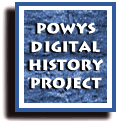

Return to the "Newtown Three" Introductory Page
The Rev. Evors was the owner of considerable property in the Newtown area. He was the grandson of Sir John Pryce and he acquired the Newtown Hall estate from the family and its creditors. He was a member of that property owning class which had so much power and influence in the early 19th century. His early involvement in politics would seem to suggest he held liberal, reformist views. He campaigned on behalf of candidate Col. John Edwards in elections in 1832 but his speeches reveal personal resentment at the stranglehold the Wynnstay and Powis Castle estates held in the politics of Montgomeryshire rather than a real concern for the rights of the individual. His involvement with the anti-Poor Law movement in 1837 was probably also motivated by a personal loss of influence in poor relief matters to the new Poor Law Unions.
In the face of growing political activity on the part of Montgomeryshire textile workers through Friendly Societies and Political Asssociations he soon showed his reactionary colours. When a meeting was organised for Caersws by local Chartist Unions on Christmas Day 1838, Evors and another magistrate called in 35 special constables and the Montgomeryshire Yeomanry cavalry, although the meeting passed off peaceably. Evors was involved in ordering the arrest of anyone suspected of Chartist activity or training and drilling working men. Historians of the Chartist riots in Llanidloes agree that Evors was involved with others in engineering events in the town to discredit the Montgomeryshire Chartisrts. There was widespread local condemnation of his crackdown on campaigners for reform and even the military complained that he was too quick to involve them. In June 1839 an un-named Llanidloes juror - and therefore, like Evors, a member of the property owning classes - wrote to the Shrewsbury Chronicle complaining of the actions of the authorities. He claimed that "some half a dozen lawyers and some clergymen throw themselves into airs of alarm and are almost ready to declare the world at an end merely because they themselves are obnoxious to anything". The letter concluded with a suggestion that Evors and two others "should be relieved of their magisterial functions".
In 1841 Evors defected to the Conservative interests in the election and he was attacked at his home at Newtown Hall by an angry mob on polling day. Two hundred and sixty police specials - mainly estate labourers of Conservative Sir Watkins Williams Wynn it was claimed - were sworn in and sent to defend Evors. The battle for the gates to Newtown Hall was ferocious with twenty police specials being injured (one fatally) before the Rifle Brigade was called out and the crowd scattered. It was claimed that Evors had urged the soldiers to fire on the crowd though he denied it. He was still arguing for the use of the military in the town weeks later.
Rev. Evors died in mysterious circumstances in 1844. He had promised to leave his estate to his brother-in-law Mr Hobday Lade who had helped him financially in his earlier years. While visiting Mr Lade�s son, Evors died of an overdose of laudanum and was found to have �8,000 in cash on him. The younger Mr Lade�s housekeeper claimed this money had been given to her master and lacking evidence to the contrary the inquest accepted this though it was later discovered that the housekeeper was actually married to Evor�s nephew. When the will of Rev. Evors was read it was discovered that he had left his estate to other relatives.
Or,
Return to the "Newtown Three" Introductory Page
